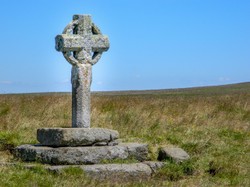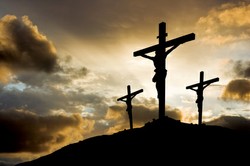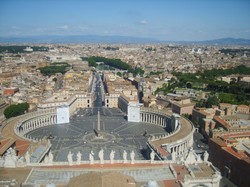On a lonely moorland stands a Celtic cross, a mute, treasured and now weathering memorial to an ancient Christian tradition. Note that it combines a cross and a disc, a union of Celtic and Christian symbolism. The cross speaks for itself as a symbol of Christ, but the disc stands for the sun and its light, which for the cultures loosely known as Celtic was the expression of the divine presence in the world. Christianity has ever drawn upon philosophy to reflect on its traditions, and while the church as a whole drew upon Hellenistic thought derived from Greece, Celtic Christians drew also upon older druidical traditions that saw light as the manifestation of divine presence.
This unique melding of Christian faith and Celtic culture is shown in the artistry of the cross.Each cross is different, but the common element to all is that scriptural stories are told through their carvings. The Catholic Church, with which the Celtic Church was in communion, has ever believed that religious truth can be expressed not only in word, but in pictures and ritual actions. But alongside the Christian art the Celtic church took aboard the artistic conventions of Celtic culture, and so we see the elaborate knotwork designs seen in Celtic artefacts across Europe all being replicated on the stonework of the cross.
The cross is linked with another aspect of Celtic Christianity,the elevated status that it gave to monks. The contrast with Roman Christianity is evident. While the Roman and Orthodox churches are ruled by bishops, each of whom is based in a specific town, the Irish dwelt in a land where towns were small and and few, and so the dominant characters were monks based in the abbeys that flourished in Celtic lands. Bishops were chosen from monks, but were subject to the abbot's rule. It was the monks who used the Celtic crosses, for they would gather worshipers around the cross and use the pictures as a resource to support preaching.
A major influence upon Irish monasticism was Egyptian Christianity, which seems to have reached Ireland before St Patrick did, as Patrick was sent to the Britons who believe in Christ in the island of Ireland, implying that Christians were there already. Scholars believe that St Kevin, founder of Glendalough Abbey in Wicklow, antedates Patrick. Evidence of an Egyptian influence is that Kevin is said to have prayed in the Egyptian way, standing with arms stretched wide.
Another sign of Egyptian influence upon Irish Christianity is that Irish monks often copied the example of the Egyptian desert fathers, hermits who sought God in the desert. Many Irish monks became hermits, seeking their own personal desert in remote places, such as islands, where they would place their cell. We can still find their traces in place names, for many locations in Ireland have names beginning with kil [for kella, cell] and in Wales there is a place called Dyserth, meaning desert, after an anonymous hermit who found his desert there.












 TheThousand Year Garden29 days ago
TheThousand Year Garden29 days ago
 Women of the Gospelson 10/11/2025
Women of the Gospelson 10/11/2025
 Religious Gardenson 08/25/2025
Religious Gardenson 08/25/2025
 Doctor of the Church: John Henry Newmanon 08/03/2025
Doctor of the Church: John Henry Newmanon 08/03/2025



Comments
Ireland had long had trade relationships with the Mediterranean region. Religion went along the trade routes..
The fourth paragraph to the first subheading, The Celtic Cross, advises us that "Evidence of an Egyptian influence is that Kevin is said to have prayed in the Egyptian way, standing with arms stretched wide."
Is it known how it is that St. Kevin was versed in Egyptian ways?
120 is the limit to human longevity, so this age is not impossible.
Thank you for your comment below in answer to my previous observation and question.
The third paragraph to the first subheading, Celtic cross, advises us that "A major influence upon Irish monasticism was Egyptian Christianity, which seems to have reached Ireland before St Patrick did, as Patrick was sent to the Britons who believe in Christ in the island of Ireland, implying that Christians were there already. Scholars believe that St Kevin, founder of Glendalough Abbey in Wicklow, antedates Patrick."
English Wikipedia dates St. Kevin as born in 498 and dying Jun 3, 618.
Does Christian tradition defer to St. Kevin as dying as a 120-year-old?
Yes.,most certainly. It is the same style of art
The second paragraph to the first subheading, Celtic cross, advises us that "we see the elaborate knotwork designs seen in Celtic artefacts across Europe all being replicated on the stonework of the cross."
Could it also be considered that illuminated manuscripts culled those knotwork designs in their illuminations?
I don't know about the endless patience bit!
Frank is a wonderful teacher and has endless patience. He has taught special education and has a great way of explaining things.
Thanks!
Very interesting article.